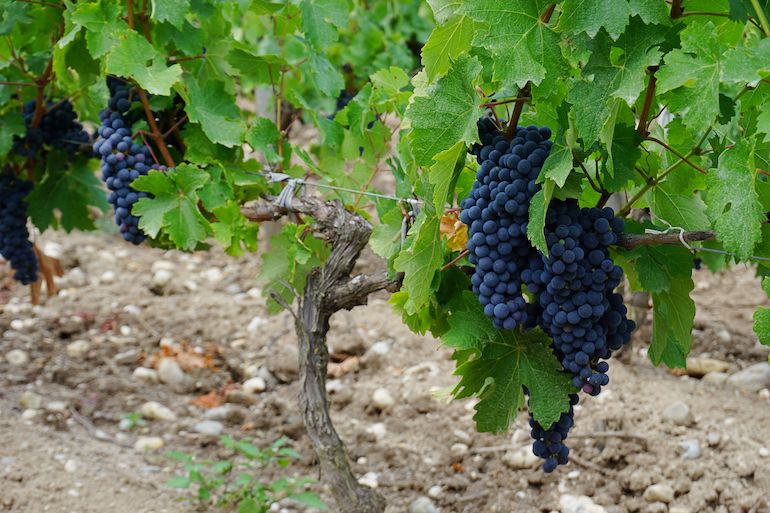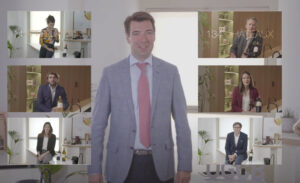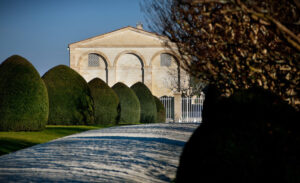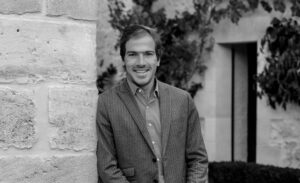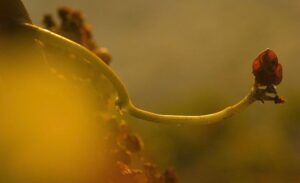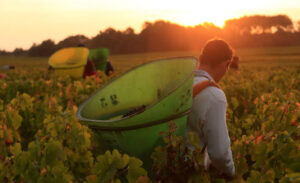Margaux Harvest Notebook, 2021
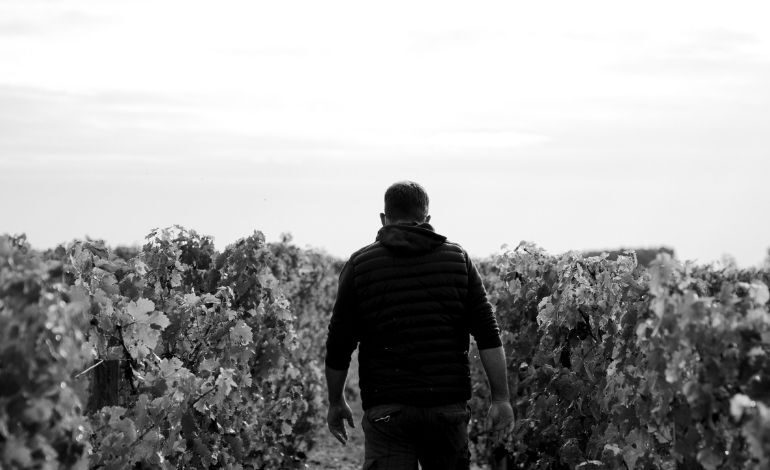

For the Margaux harvests, we set out to walk the paths of one of the most famous appellations in the world. A royal journey to discover châteaux of legend with their eyes fixed firmly on the future.
DAY 1
Welcome to the most famous vineyard in the world! Margaux sets the tone straightaway. A sign informs new visitors that they are not just anywhere, but well and truly in an appellation of legend. Having left Paris at dawn by TGV, we entered the heart of the myth at 11.00 am.
The first stage of the tour unfolds under a changeable sky, at the end of an earthen path winding between hectares of vines. Wine merchant John Lewis Brown established his château here nearly 200 years ago. As we catch sight of the large, well-appointed Tudor-style residence, we almost fancy ourselves in Oxford or Cambridge. However, the flag floating before the estate leaves no room for doubt. Cantenac Brown is a Scottish principality right in the heart of the Médoc. The first owner came from the Brown clan of Colstoun, whose motto is “floreat majestas”, “that the flower may bloom”, in English.
Now it’s the turn of José Sanfins, director general of the château, to make this motto prosper. The man has his work cut out in this harvest season, and an emotional rollercoaster to manage. The previous weekend the weather forecast – which he consults regularly – predicted 20 millimetres of rainfall. Finally, no more than 7 fell. His team could get to work among the ranks of Cabernet Sauvignon.
A plot of land with men on it
José Sanfins has witnessed more than a few harvests at Cantenac Brown. He arrived here as Technical Director in 1989. He was 26 years old when Jean-Michel Cazes took the gamble of entrusting him with the keys to this magical place. José grew up on Patiras island, just off Pauillac, and spent his childhood among the vines where his family, originally from Portugal, worked. The man who confides he has the “impression I was born knowing how to roll a barrel” knows the Médoc like the back of his hand, and loves it like no one else: “this place is blessed by the Gods”, he comments in amazement.
However, the vintage was difficult to tame, the rain did not spare the vines this summer, and there was less sunshine. Nevertheless, the Director General is not worried: “When nature gives everything, the work is easier. It’s with complicated vintages that you feel the human touch. My favourite vintages are not necessarily the greatest, but the ones where we gave everything we had”.
He has a special affection for the 2013 vintage, remembering with emotion a weekend when they had to take advantage of a lull in the weather to harvest with every available hand in the region: “we had to call on everyone, regardless of their normal work. We were bringing in the grapes up until midnight. 14 hectares harvested in 2 days! It was magnificent!” As an ex-amateur rugby player, he has a special affection for the team spirit and sacrifice, when the men unite as one and work together toward a common goal. That’s how he sees his job. For him, a terroir “is a plot of land with men on it”. Then it is up to them to make the best of the grapes the earth gives them and, by dint of relentless work, technical know-how and judicious insight, to create an extraordinary product.
But right now, it is time to take our seats at the table for a welcome break and a harvester’s lunch in the dining room of the château. On the menu, a fortifying fish soup and roast pork accompanied by a 2005 Cantenac Brown, carefully selected by Pauline Fradin. José conjures up his memories as the sun makes a generous breach in the clouds. Outside the sheep (a Scottish breed, naturally!) venture up to the windows. They have been there for some years now, peacefully cropping the grassland hugged in between the grounds and the facade of the château.

A new wind blows in Margaux. Since 2013 the appellation has engaged in a collective approach: Margaux, Terroir de Biodiversité (Margaux, Terroir of Biodiversity). The goal? To preserve and restore the diversity of the fauna and the landscapes. As many as 25 estates have engaged in more than 350 action projects, accounting for 85% of the appellation. In the south of the Médoc, they have opted to be pioneers, to upgrade practices and promote the emergence of innovative and environmentally-friendly viticulture. Some 13% of the appellation’s wine-growing area has already converted to organic and biodynamic methods. A few kilometres away, Château du Tertre is progressively making the transition. As for Château Dauzac, for several years now it has engaged in an intelligent biodynamic approach “which outstrips the certification”, comments Laurent Fortin. We will have an opportunity to witness this later.
A new vat room for truly great wines
For the moment, it is time for a pleasant constitutional stroll around the château. In front of the property, we take a path by which travellers arrived at Cantenac Brown in bygone days. With a little imagination, we can almost see the illustrious visitors marvelling at the beauty of the surroundings as they arrive in horse-drawn carriages. Then we venture into the forest, the entrance to which is marked by an immense sequoia. Visitors will soon be able to ramble through the grounds at their leisure, purchase a bottle and savour it in these enchanting surroundings.
They will also have the opportunity to discover the latest major project for Cantenac Brown, which José describes with great enthusiasm. The plan is to build a new cellar made of raw earth with a 12-metre-high vault! To do so, José Sanfins and Tristan Le Lous, the owner, called in Philippe Madec, the architect, who will use an ancestral technique, rammed earth. The result: an ecologically-friendly building, the only one of its kind in the world, should be completed in 2023. José Sanfins is not a little proud: “raw earth is perfectly suited to producing truly great wines. The earthen walls will be one metre thick, generating practically no variation in temperature, it’s ideal for preserving wine”. A symbol of the innovative ambition of an appellation that never rests on its laurels. We leave Cantenac Brown, promising to return to see this new, one-of-a-kind wine cellar.
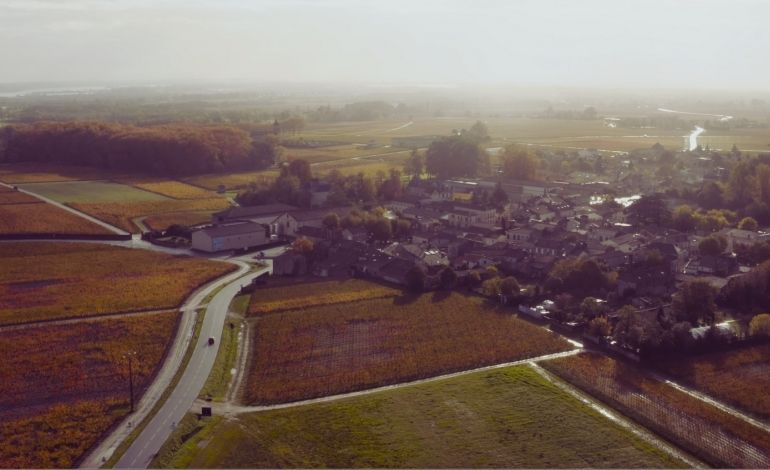
Pickers are busy in the Margaux vineyards as we make a fruitless foray into the forest in search of cep mushrooms. After a short break on the banks of the Gironde and a quick coffee at Arsac, we make our way to the next stage of our tour, Château du Tertre.
A large gateway opens onto an earthen path. At the end, a large elegant property overlooking 52 unbroken hectares of vineyards enjoys a magnificent aspect. This is the high point of the appellation.
As we enter the château, we are amazed by the atmosphere that reigns throughout. The decoration is meticulous and the atmosphere warm and friendly. Flemish decorator Axel Vervoordt has restored the premises to their former glory. We settle into a large room on the first floor. The view of the vineyard is breathtaking. The furniture is exquisite, the toile de Jouy adds a special touch to the overall effect. An ideal cocoon in which to relax before our tour with the owner and dinner with Cynthia Capelaere, director of Château du Tertre. We savour a very pleasant glass of white Tertre while Cynthia recounts the history of our surroundings, the pursuit of excellence that guides her, and the intense work during the harvest period. In fact, we too are going to lend a hand. It is time for bed in order to be fighting fit in the morning!
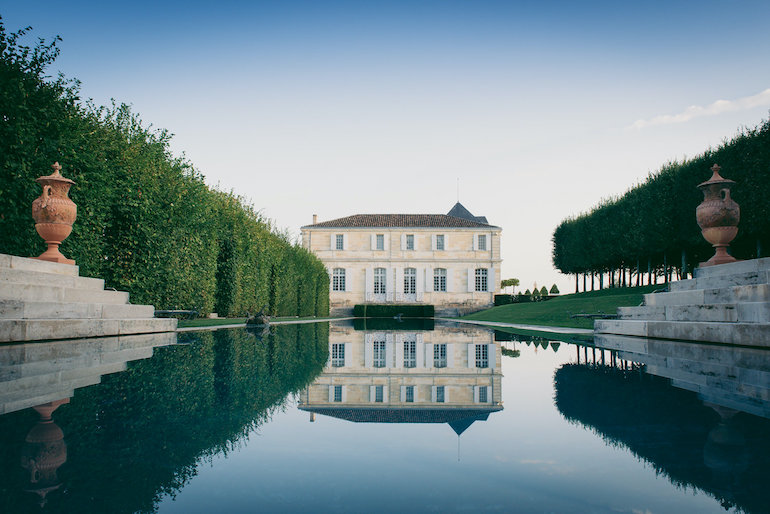
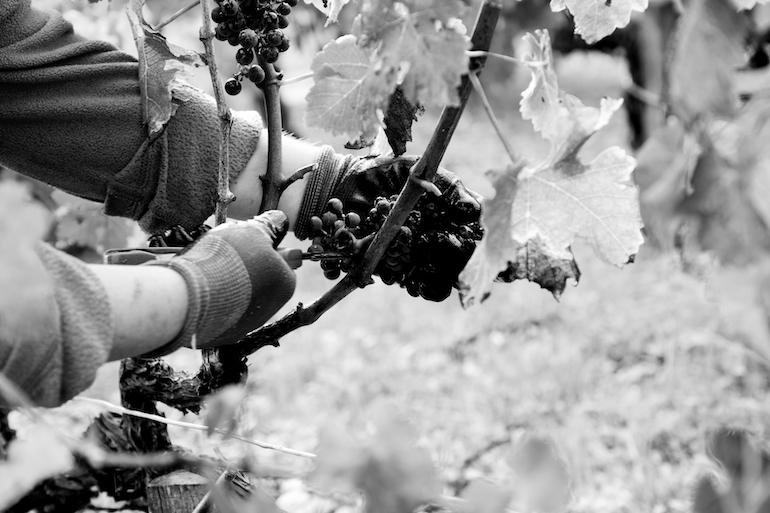
DAY 2
A dawn jog through the vines to start the day, or a bike ride around the estate. A sporting start to the day, but the weather got the better of our glorious ambitions. Instead, we opted for breakfast in the magnificent orangery, positioned behind a majestic 52-metre-long swimming pool. The swim will have to wait for our next visit! Time to don our boots and set out for the vines. It is 8.30 in the morning, the rain is pouring down non-stop on Margaux and the harvesters are already at work. The cutters snip the clusters of Cabernet Sauvignon and fill the porters’ baskets. Who take the harvest to the tractors and trailers that wend their way back and forth to the courtyard of the estate and the sorting table.
Rainy harvests, happy harvests
Among the vines, Romain the vineyard manager is giving the orders. With his yellow Guy Cotten overalls, he is dressed up like a Breton sailor ready to brave a storm: “a harvest without rain wouldn’t really be a harvest!”, he jokes, assigning secateurs to us and a rank to harvest. Next to us, they keep busy while discussing the latest Netflix series. The harvesters’ hands are agile, cutting with surprising speed and dexterity as we struggle to keep up with the pace. After half an hour’s harvesting, our backs stooped and boots spattered with earth, we fill one of the porters’ basket as he advances with 21 kilos of grapes on his back and we walk back to the winery, making our way to the sorting table where talented women are busy separating the last leaves from the clusters of grapes.
After a morning’s work, it is time for the harvesters’ lunch, a long-standing tradition in the Médoc! Although all agree that it is increasingly difficult to find workers, this continues to be a special moment, both friendly and important. A large table has been set in the barn. Cynthia chats with the château teams. Lunch is also an opportunity to evaluate the morning’s work, to take the time to discuss the next steps and plan which plots to harvest tomorrow so that the grapes are perfectly ripe when they arrive at the winery. Like a general outlining a plan of battle, Romain unfolds a map of the estate’s plots as he sips his coffee. Everything is rigorously calculated down to the nearest millimetre. This is the kind of commitment and precision required to produce 200,000 bottles of red wine. He takes the time to patiently explain the different grape varieties in the vineyard to us beginners. Cabernet Sauvignon here, Merlot there, Cabernet Franc over there.

Among the Château du Tertre teams, there are ordinary people from the four corners of France and all over the world who have come to the Médoc, bringing their knowledge and culture with them. The cellar master is from Alsace. Around the large banquet table, there is a Greek woman, an Australian and an Irishman. The former owners were Dutch. Reminding us that Château du Tertre has always been a land of exchange. That innovation and multi-culturalism has been part of its DNA ever since Pierre Mitchell, an industrialist from Ireland, built a château here and created a winegrowing estate in the 18th century. Mitchell was ahead of his time. This glasswright is reputed to have created the Jeroboam, but also the Bordelaise, bottles that are still the stuff of legend 300 years later. The same avant-garde spirit still guides his successors today.
2.30 pm. It is time to set out again, with a few bottles of white Tertre and a 2015 grand vin in the boot of the car on our way to the last stage of the journey. An estate that is also in the throes of renewal, and was also ranked Grand Cru in 1855. Château Dauzac, located in the south-east extremity of the appellation, on the banks of the Gironde. The heart of Dauzac beats yellow and black. The colours of the estate are omnipresent, as if to remind us of its identity. We are immediately welcomed by Laurent Fortin, the manager. A man whose Franco-American culture is sometimes surprising in the Bordeaux vineyards. He proclaims it loud and clear: “Bordeaux is sophisticated but it mustn’t be pedantic. Today we have to address a new clientele, like the millennials”.
Tradition and avant-garde
To do so, Laurent Fortin has engaged Dauzac (since 2016) in an approach that promotes biodynamic agriculture and biodiversity. As at Cantenac Brown, sheep are grazing on the estate. Egrets and herons are regular visitors to the estate. Laurent Fortin has a passion for beekeeping and has even installed 18 hives, with the château producing its own honey. As for the wine, it is certified vegan and, to combat mildew, copper has been replaced by algae. Laurent also works with his teams to modernise the image of Dauzac. Posters in the winery display the codes of mid-century tour operators and airline companies, and have Dauzac travelling elegantly throughout the whole world, to Moscow, New York and the Mont Saint-Michel. The message is clear. Dauzac is open to the world and owes it to itself to be innovative: “innovation is part of our DNA. The history of Dauzac is made up of visionaries and new ideas. Like the Johnstons, for example, who developed the famous bouillie bordelaise to save European vines from mildew. Or later, another former owner, Jean-Jacques Bernat, an industrial ice-maker who had the idea for thermoregulation by using ice blocks to slow fermentation in the vats”. Now innovation involves the use of transparent double staves but also a new way of thinking.
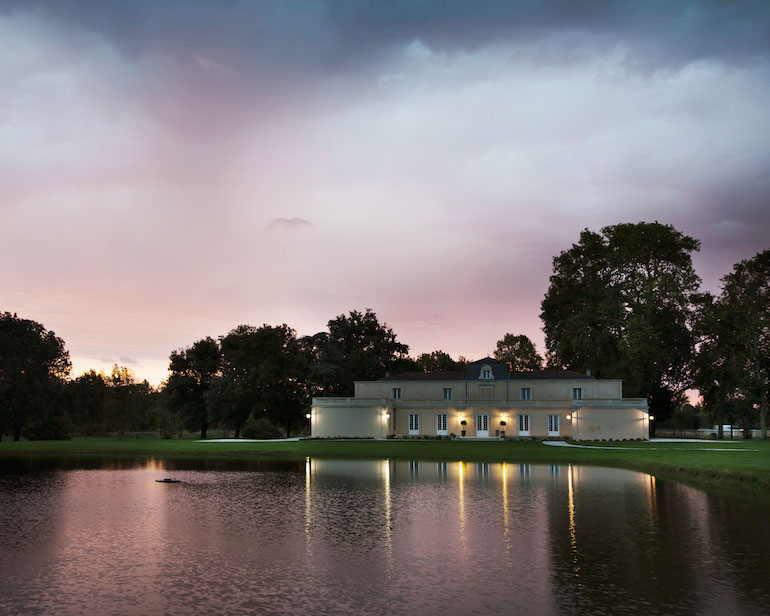
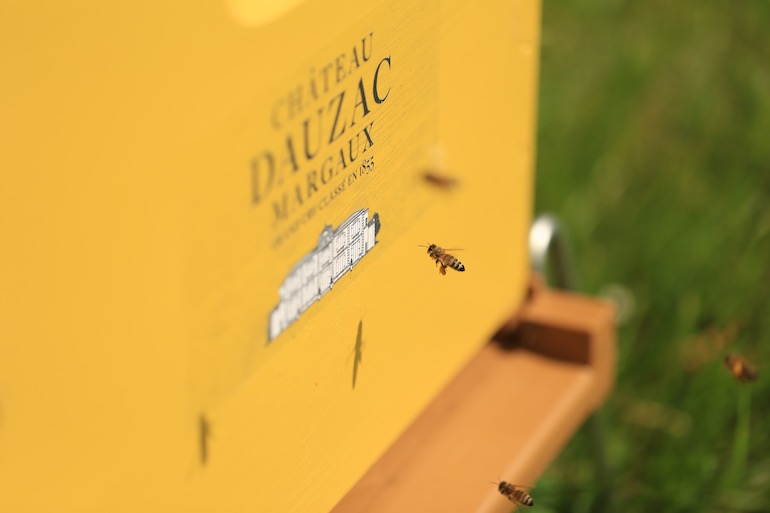
Laurent Fortin is keen to introduce us to a project that is symbolic of the mindset at Dauzac. He sets off into the vines at the wheel of his vehicle, stopping at a plot where the vines look scrawny: “they’re not! But they have no rootstock. These are non-grafted vines. On non-grafted vines, the deep roots develop before the foliar surface”, he explains. The plot is one hectare. Until it was acquired in 2014, it was part of a manor house estate. It was here, in this terroir, far from aphids and phylloxera that Laurent Fortin and his teams decided in 2014 to replant non-grafted vines from the château’s most beautiful vines in order to satisfy a major ambition: to rediscover the original taste of Cabernet Sauvignon.
A taste that has been forgotten since phylloxera arrived in 1867. Last year, his teams did a test harvest and Laurent Fortin discovered something totally new: “it’s a taste we don’t know. There is a typicity specific to Cabernet Sauvignon, but the taste and the colour are closer to Pinot Noir”, he confides. This year, 2021, marks the harvest of the first vintage of non-grafted Château Dauzac that is destined to be released on the market. The dedicated cuvée will appear in 2023, after ageing for two years in amphoras, in strict accordance with ancestral traditions. Yet further proof that at Margaux, innovation and tradition are never contradictory: “today’s tradition is yesterday’s innovation”, concludes Laurent Fortin. That may very well be the moral of this magical journey to Margaux. A myth can look confidently to the future, provided it is always a precursor. The men and women of the appellation understand this. So do we.
Arthur Jeanne
